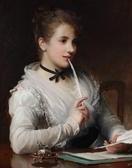"Che cosa state facendo, buona donna?" chiese la principessa.
"Sto filando, mia bella bambina," rispose la dama, non sapendo chi fosse.
"Oh, che divertimento!" gioì la principessa. «Come si fa ? Fatemi provare per vedere se riesco a farlo altrettanto bene."
In parte perché troppo frettolosa, in parte perché era un po' disattenta, ma anche perché l'incantesimo della fata aveva decretato che così accadesse, non appena afferrò il fuso, la fanciulla si punse la mano e cadde in deliquio.
In grande allarme la dama gridò per chiamare aiuto. Le persone accorsero da ogni parte per gettare acqua sul viso della principessa, sfregarle le mani sul volto, massaggiarle le tempie con l'essenza reale di Ungheria, ma nulla servì a rianimarla.
Allora il re, che era stato portato al piano di sopra perchè vinto dalla commozione, si ricordò della profezia delle fate. Ebbe la certezza che quanto predetto si era avverato e diede ordine che la principessa fosse collocata nel migliore appartamento nel palazzo, sopra un letto ricamato in oro e argento.
Si sarebbe potuto pensare che fosse un angelo al guardarla, tanto era fiera. Il sonno profondo non le aveva tolto il bel colore della sua carnagione. Aveva le guance delicatamente rosate, le labbra rosse come il corallo. I suoi occhi, erano chiusi, ma il suo dolce respiro poteva essere udito, ed era quindi evidente che non fosse morta. Il re ordinò quindi che fosse lasciata dormire in pace fino a quando fosse giunta l'ora del suo risveglio.
The Sleeping Beauty in the Wood, Charles Perrault
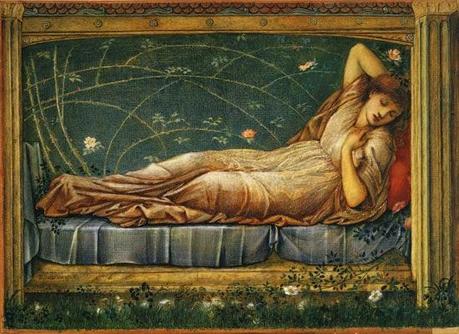
The Sleeping Beauty, 1871 by Burne-Jones, Sir Edward Coley
Quella de ' La Bella Addormentata nel Bosco', come l'abbiamo tradotta e la conosciamo noi tutti in italiano è forse una delle fiabe più antiche, sicuramente una tra le più celebri.
Scritta da Charles Perrault con il titolo originale di "La Belle au Bois Dormant" e pubblicata nella raccolta 'Contes du Temps Passé' nel 1679, tradotta in inglese in 'The Histories of Past Times, o The Tales of Mother Goose: With Morals. London: B. le Francq nel 1785 ed in tedesco dai fratelli Grimm con gli inizi del XIX secolo, attingerebbe la propria origine, secondo Andrew Lang, noto studioso di mitologia del 1800, dal mondo mitologico classico.
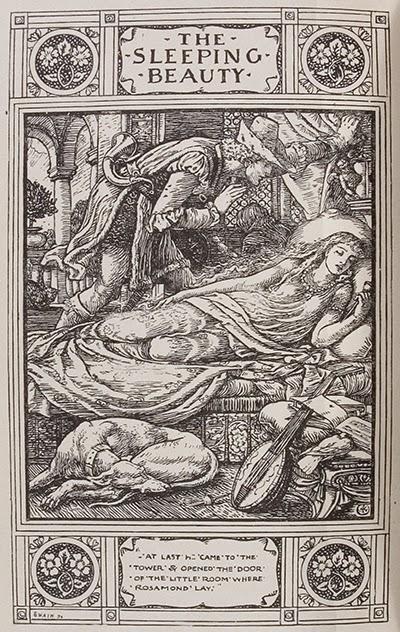
Translated from the German by Lucy Crane and done into pictures by Walter Crane. Household Stories- From the Collection of the Brothers Grimm. New York- R. Worthington, 1883
Poteva un racconto così tanto avvolto di mistero e di magia non essere di ispirazione per un pittore preraffaellita che, obbedendo ai canoni estetici fissati dalla confraternita cui apparteneva, trasponeva sulla tela, nella costante ricerca di un equilibrio, storia, fede, mito, arte e natura ?
Era Edward Coley Burne-Jones (1833 - 1898) un artista a tutto tondo, come tanti ne aveva concepiti l'epoca vittoriana, soprattutto Londra, e non è questo un caso considerato che divenne a quel tempo, grazie alla Regina Vittoria non solo capitale della cultura, ma anche la più grande metropoli del mondo con 4,2 milioni di abitanti nel 1890, quando New York ne contava 2,7 e Parigi 2,5: coinvolto attivamente nel recupero dell'antica arte della lavorazione del vetro colorato e pitturato nelle vetrate degli edifici di culto in stile gotico, egli legò il suo nome a numerosi capolavori che ancor'oggi si possono ammirare, tra gli altri, presso la St.Philip's Cathedral di Birmingham, St. Martin in the Bull Ring, Birmingham, The Holy Trinity Church a Chelsea, St. Martin's Church in Brampton, Cumbria, St. Michael's Church, Brighton, All Saints, Cambridge Christ Church, Oxford e in St. Anne's Church, Staffordshire, Moorland.Aveva cominciato la sua brillante carriera come giovane pittore sensibile all'influenza degli amici e maestri Dante Rossetti e Wiliam Morris
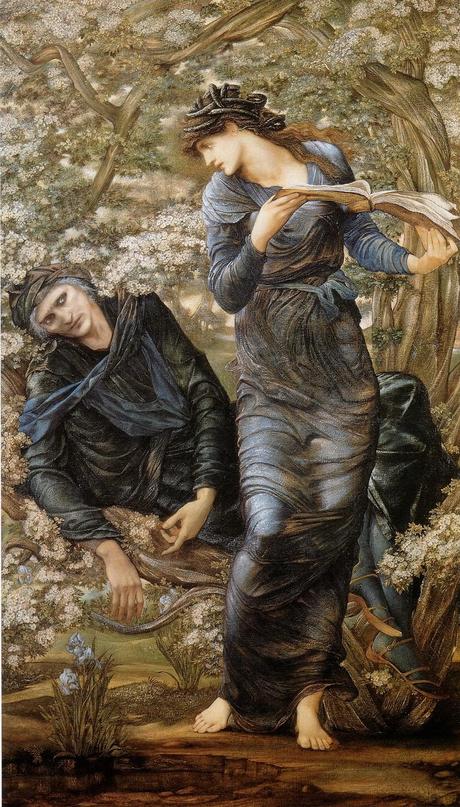
The Beguiling of Merlin, 1877
ed era divenuto inoltre celebrato ceramista, illustratore, creatore di scenari per rappresentazioni teatrali, e disegnatore di costumi per gli attori ... Burne-Jones aveva col tempo acquistato padronanza in ogni ambito appartenente alle arti grafiche, ma ciò che credo senza dubbio alcuno rappresenti il culmine della sua maturità e della sua produzione artistica sia il 'ciclo pittorico' che egli dedicò alla leggenda di Briar Rose: portato a compimento nel 1890, lo aveva tenuto impegnato per ben 30 anni.
Esso consta di quattro pannelli affrescati di grande dimensioni che rappresentano non altrettanti momenti significativi della narrazione, come a tutta prima si potrebbe esser portati a pensare, bensì immortalano uno stesso momento, quello topico dell'addormentamento della principessa Briar Rose, in quattro luoghi differenti del regno che le appartiene; a rendere di ulteriore prestigio tali affreschi, l'iscrizione sotto ciascuno di essi di una quartina tratta dal poema di William Morris ' The Briar Wood '
THE BRIAR WOOD
"The fateful slumber floats and flowsAbout the tangle of the rose.But lo the fated hand and heartTo rend the slumberous curse apart."
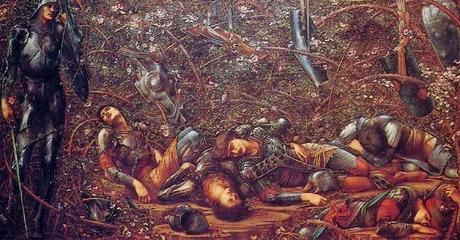
"Il sonno fatato scorre e scorre ancora attorno al groviglio della rosa. Ma ecco la mano fatale e il cuore A scacciare via la sonnolenta maledizione. "
THE COUNCIL CHAMBER
"The threat of war the hope of peaceThe Kingdoms peril and increaseSleep on and bide the latter dayWhen fate shall take her chain away."
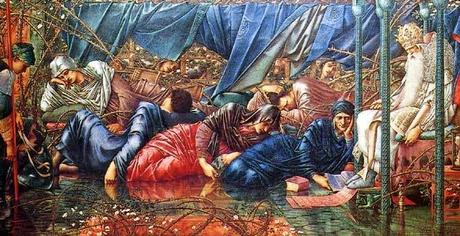
"La minaccia della guerra la speranza della paceIl pericolo dei Regni che cresceSopra ci si dorme e si aspetta quest'ultimo giornoQuando il destino scioglierà definitivamente l'incanto"
THE GARDEN COURT
"The maiden plaisance of the land
Knoweth no stir of voice or handNo cup the sleeping waters fillThe restless shuttle lieth still."
"La piacente fanciulla di quel luogoNon riesce ad emetter voce o a mover manoLe acque dormienti non colmano alcun caliceLa spola inquieta ancora giace. "
THE ROSE BOWER
Here lies the hoarded love the key
To All the treasure that shall beCome fated heart the gift to takeAnd smite the sleeping world awake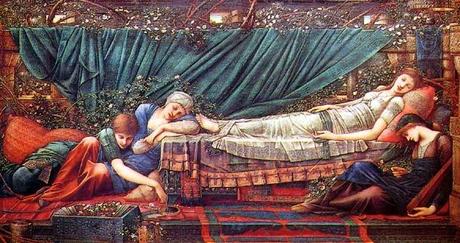
Dell'amore tesaurizzato giace qui la chiavePer ciascuno tesoro dovrà rappresentareAffinché il cuor fatale il dono possa ricevereE scuotere, destando, il mondo addormentato.
Nel 1890 i dipinti furono acquistati da Agnew & Sons per £ 15.000 ed esposti nella loro galleria d'arte dove rimasero per poco tempo poichè presto andarono a decorare le pareti della sala della musica della signorile residenza di Buscot Park.
La serie venne infatti acquistata da Alexander Henderson, che in seguito divenne il I° Lord Faringdon, proprietario di Buscot Park, nella contea dell' Oxfordshire; quando Burne-Jones, poco tempo dopo, mentre alloggiava con Dante Gabriel Rossetti nel vicino Kelmscott Manor, ebbe l'occasione di visitare la dimora di Lord Faringdon, notò, nell'osservare i suoi dipinti, che faceva loro difetto la mancanza di un'appropriata cornice, e perciò ne disegnò una di legno intagliato e dorato.
Burne-Jones aggiunse poi alla serie originaria altre dieci scene di dimensioni minori in modo che le immagini formassero un fregio ininterrotto che avvolgesse per intero le pareti della stanza: egli voleva che i visitatori della sala della musica avvertissero di aver realmente fatto un salto nel mondo incantato di The Briar Wood, trovandosi completamente circondati da immagini che lo rappresentavano.
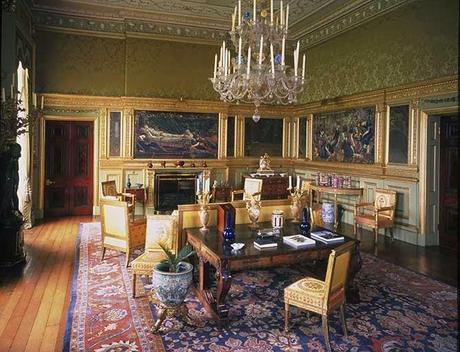
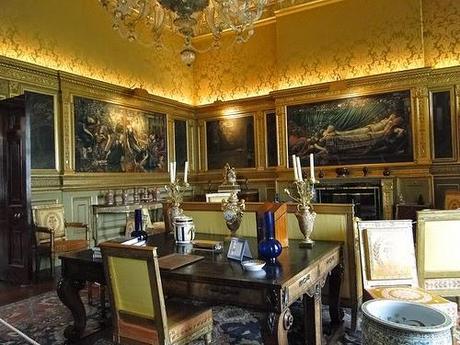
Da notare come egli, nel dipingere, abbia scelto la figlia Margaret quale modella per la principessa Briar Rose e a ciò, forse, si deve l'aver del tutto spogliato la vicenda narrata dell'anche seppur minimo accenno di sensualità: la storia infatti non si conclude con il bacio del principe in grado di ridestare Rose, ed a questo proposito Peter Faulkner suggerisce come conclusivo ideale dell'intero ciclo il dipinto Wake Dearest (1898) che appartiene alla raccolta The Flower Book, una serie di 38 acquerelli pubblicati postumi dalla moglie ormai vedova nel 1905

in cui alla figlia Margaret si sostituisce la moglie Georgiana ed in cui finalmente il principe che già conosciamo si avvicina alla bella principessa porgendole una carezza.
Ancor oggi la serie di The Briar Rose può essere ammirata presso Buscot Park, ora di proprietà del National Trust.


Fonti bibliografiche:
Caroline Ascott, William Morris and Edward Burne-Jones. Interlacings, New York and london, Yale Unuversity Press, 2008
Georgiana Burne-Jones, Memorials of Edward Burne - Jones, 1904, London; Lund Humphreys, 1993
Peter Faulkner, The Briar Rose, The Journal of William Morris Studies, Winter 2009, page 56 - 63, The William Morris Society in the United States, Editor Patrick O'Sullivan
Penelope Fitzgerald, Edward Burne - Jones, 1975, Stroud: Sutton Publishing, 2003
Frances Spalding, Magnificent Dreams. Burne - Jones and the Late Victorians, Oxford, Phaidon, 1978

"What are you doing, my good woman?" asked the princess.
"I am spinning, my pretty child," replied the dame, not knowing who she was.
"Oh, what fun!" rejoined the princess. "How do you do it? Let me try and see if I can do it equally well."
Partly because she was too hasty, partly because she was a little heedless, but also because the fairy decree had ordained it, no sooner had she seized the spindle than she pricked her hand and fell down in a swoon.
In great alarm the good dame cried out for help. People came running from every quarter to the princess. They threw water on her face, chafed her with their hands, and rubbed her temples with the royal essence of Hungary. But nothing would restore her.
Then the king, who had been brought upstairs by the commotion, remembered the fairy prophecy. Feeling certain that what had happened was inevitable, since the fairies had decreed it, he gave orders that the princess should be placed in the finest apartment in the palace, upon a bed embroidered in gold and silver.
You would have thought her an angel, so fair was she to behold. The trance had not taken away the lovely color of her complexion. Her cheeks were delicately flushed, her lips like coral. Her eyes, indeed, were closed, but her gentle breathing could be heard, and it was therefore plain that she was not dead. The king commanded that she should be left to sleep in peace until the hour of her awakening should come.
The Sleeping Beauty in the Wood, Charles Perrault
- picture 1 - The Sleeping Beauty,1871 by Burne-Jones, Sir Edward Coley
That of
'The Sleeping Beauty' is perhaps one of the oldest fairy tales, surely one of the most famous. Written by Charles Perrault with the original title of "La Belle au Bois Dormant" and published in the collection 'Contes du Temps Passé' in 1679, translated in English in 'The Histories of Past Times, or The Tales of Mother Goose: With Morals'. London: B. the Francq in 1785 and in German by the Brothers Grimm in the early XIXth century, it would draw its origin, according to Andrew Lang, renowned scholar of mythology of the 1800s, from the classic mythological world.- picture 2 - Translated from the German by Lucy Crane and done into pictures by Walter Crane. Household Stories- From the Collection of the Brothers Grimm. New York- R. Worthington, 1883
Could a story so steeped in mystery and magic to not be of inspiration for a Pre-Raphaelite painter who, in obedience to the aesthetic principles governed by the brotherhood which he belonged to, transposed onto the canvas, in a constant search for balance, History, Faith, Myth, Art and Nature ?
Edward Coley Burne-Jones (1833 - 1898) was an all-round artist, as lots had the Victiorian era conceived, particularly in London, and this is not a case considered that, thanks to Queen Victoria, it beacme not only capital of the culture of the time, but also the largest metropolis in the world with 4.2 million inhabitants in 1890, when New York counted 2.7 and 2.5 Paris: actively involved in the recovery of the ancient art of making stained and painted glass in the windows of ancient churches in the Gothic style, he linked his name to a number of masterpieces that even today we can admire, such as, among the others, at the St.Philip's Cathedral in Birmingham, St Martin in the Bull Ring, Birmingham, The Holy Trinity Church in Chelsea, St. Martin's Church in Brampton, Cumbria, St. Michael's Church, Brighton, All Saints, Cambridge Christ Church, Oxford, and St. Anne's Church, Staffordshire, Moorland.
He began his career as a young painter sensitive to the influence of his friends and teachers Dante Gabriel Rossetti and William Morris
- picture 3 - The Beguiling of Merlin, 1877
and became also acelebrated potter, illustrator, creator of scenarios for theatrical performances, and costume designer for the actors ... Burne- Jones, over the time, acquired mastery in all areas belonging to the graphic arts, but what I think without any doubt represents the culmination of his maturity and his artistic production is the 'cycle of paintings' which he dedicated to the legend of Briar Rose: accomplished in 1890, it had kept him busy for 30 years.
It consists of four painted panels in large sizes that don't correspond to just as many significant moments in the narrative, as at first we might be led to think, but them all immortalize the same moment, that topical of the falling in deep sleep of the Princess Briar Rose, in four different locations of the kingdom that belongs to her; to adding further prestige to these frescoes, the enrollment in each of them of a quatrain from the poem by William Morris ' The Briar Wood '
THE BRIAR WOOD
"The fateful slumber floats and flowsAbout the tangle of the rose.But lo the fated hand and heartTo rend the slumberous curse apart."
- picture 4
THE COUNCIL CHAMBER
"The threat of war the hope of peaceThe Kingdoms peril and increaseSleep on and bide the latter day
When fate shall take her chain away." - picture 5
THE GARDEN COURT
"The maiden plaisance of the land
Knoweth no stir of voice or handNo cup the sleeping waters fillThe restless shuttle lieth still."- picture 6
THE ROSE BOWER
Here lies the hoarded love the key
To All the treasure that shall beCome fated heart the gift to takeAnd smite the sleeping world awakeOn The Times it could be read a short article by an art critic who, about the series of The Briar Rose wrote, ' We have become accustomed to this test of loving care in the images of Lord Burne-Jones, but never before it was given us to take it on such a large scale and with such exuberance of imagination as in these four frescoes. The world of dreams and fairies certainly hasn't never been shown before with such great generosity '.
In 1890 the paintings were purchased by Agnew & Sons for £ 15,000 and exposed in their art gallery where they remained for a short time for they went to decorate the walls of the music saloon of the mansion of Buscot Park.
The series was in fact purchased by Alexander Henderson, who later became the First Lord Faringdon, owner of Buscot Park, located in county of the Oxfordshire; when Burne-Jones, shortly after, while staying with Dante Gabriel Rossetti in the near Kelmscott Manor, had the opportunity to visit the residence of Lord Faringdon, he noticed, while watching his paintings, the lack of an appropriate frame, and therefore drew up a wood carved and gilded one.
Then he added to the original series ten other smaller scenes so that the images should form a continuous frieze that wrap the entire walls of the room: he wanted the visitors of the music saloon to feel as if they really had made a leap into the enchanted world of the Briar Wood, being them completely surrounded by images that represented him.
- picture 8
- picture 9
You have to notice that he, in his paintings, chose his daughter Margaret as a model for the Princess Briar Rose and that's why, probably, he has completely stripped the story even of the slightest hint of sensuality: in fact, it doesn't end with the kiss of the prince able to awaken Rose, and in this respect Peter Faulkner suggests as the final point of the entire cycle, the painting Wake Dearest (1898) belonging to the collection ' The Flower Book ', a series of 38 watercolors published posthumously by his wife, now a widow, in 1905
- picture 10
in which his wife Georgiana replaces his daughter and where at last the prince we already know, finally goes up to the beautiful princess, handing her a caress.
Even today, the series of The Briar Rose can be seen at Buscot Park, now owned by the National Trust.


Caroline Ascott, William Morris and Edward Burne-Jones. Interlacings, New York and london, Yale Unuversity Press, 2008
Georgiana Burne-Jones, Memorials of Edward Burne - Jones, 1904, London; Lund Humphreys, 1993
Peter Faulkner, The Briar Rose, The Journal of William Morris Studies, Winter 2009, page 56 - 63, The William Morris Society in the United States, Editor Patrick O'Sullivan
Penelope Fitzgerald, Edward Burne - Jones, 1975, Stroud: Sutton Publishing, 2003
Frances Spalding, Magnificent Dreams. Burne - Jones and the Late Victorians, Oxford, Phaidon, 1978


![[Rubrica: Italian Writers Wanted #12]](https://m22.paperblog.com/i/289/2897898/rubrica-italian-writers-wanted-12-L-cIVqIF-175x130.png)



